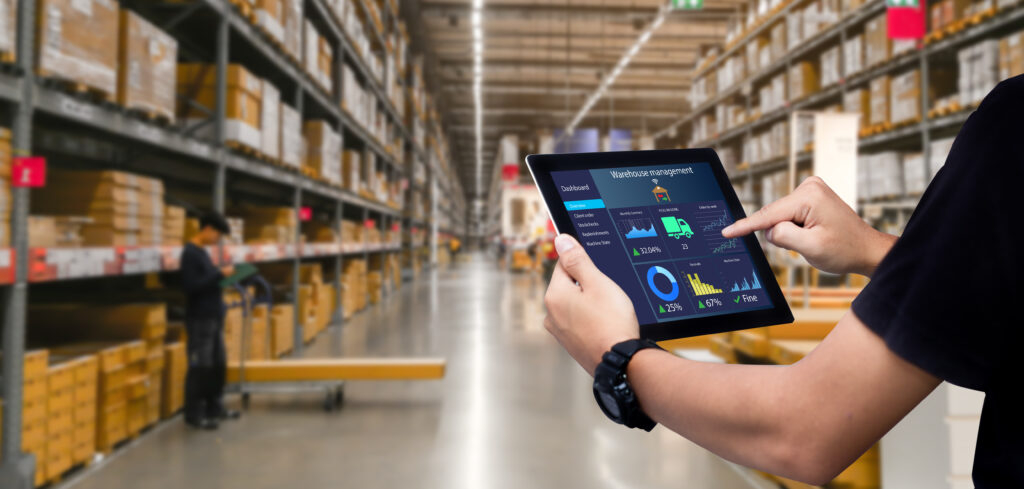Current supply chain disruptions and shifting consumer demands amid an uncertain economy mean companies must wring out every cent they can from operations. You can cut waste and increase margins by improving warehouse efficiency in your processes, material utilization, and actions like reducing shrinkage. Eliminating mistakes or enhancing how well you use inventory reduces total landed costs of goods while increasing the likelihood that your customers will have a positive experience.
The warehouse is the lifeblood of modern commerce thanks to the growth of online sales, and it’s time to trim the fat and improve that heart health.
The importance of warehouse efficiency
Warehouse efficiency covers a variety of critical inbound, inventory and outbound efforts, no matter who you receive from or ship to each day. When warehouses run smoothly, goods are protected, orders move quickly, customers are happy and employees are safe.
The goal is to have inventory flow smoothly at every point, minimizing shrinkage and errors. Warehouse policies, equipment, software and layout all play a role in running a more efficient logistics operation. As things improve, you’ll drive down errors like stockouts and mispicks that can increase returns. Many companies can better control their days to sell inventory by tracking SKU usage and setting automated alerts for inventory minimums.
While that’s important, what most companies are after is improving that efficiency. Here are some direct things to try in 2023.
Six steps to improve warehouse efficiency
Dynamic logistics swings have been the hallmark of 2020 through 2022. That has us thinking about different areas to find efficiency gains by protecting people and speeding up processes. So, beyond the standard best practices, here are a few newer options for your distribution points.
Add some space at the dock
Larger warehouses are seeing a decline in action as orders slow across the planet. This often means available docks and more time between appointments at those doors. Leverage that to create physical space between trailers and people when possible. This helps your team stay safe and limit the chance of accidents when offloading heavy goods, or if people are working to load a trailer as fast as possible. Work with your appointment and staging tools to get areas prepped ahead of any arrival. Use the space you have to care for your team.
Make reverse logistics mobile
Demand spikes are becoming more common, which unfortunately tends to come with an uptick in returns and replacements. So reverse logistics requirements fluctuate throughout the year, not just at the end of peak season.
Capitalize on this without giving up prime real estate by shifting reverse logistics processing to a mobile unit. Set aside warehouse space for whatever the most immediate need is, add rolling shelves and pallet jacks, set aside pushcarts, and move as much software to handhelds as possible. You want it to be easy to do quality assurance checks and scan SKUs back into inventory right near the door, minimizing travel time and ensuring you have available space for storage or packing when orders spike.
Review travel lanes
Usage-based slotting and dynamic slotting can increase overall warehouse efficiency by ensuring goods always fit on shelves and reducing travel times. However, these efforts sometimes create traffic jams or make units more difficult to access. Regularly reviewing travel lanes provides a smart check on your overall efforts to see where workers are getting stuck or facing issues. It may point to new picking methods or options for your space.
This is a backup to another must-have: talking to your team. Ask pickers about any issues they face and then use travel lane data to see if there is a related problem exacerbating a known issue.
Learn your picker speeds
Pickers play a significant role in warehouse efficiency. Their abilities can dramatically speed up and improve order fulfilment, while mistakes slow down every other process. Track your pickers to learn who can achieve at which speed and set tasks accordingly. Slower or newer workers can shadow your more experienced pickers, or they can be given orders that require more care and time. Base instructions on capabilities with smart routes and selection.
Set realistic expectations
A final consideration for your warehouse efficiency is to review goals and requirements, especially for pickers. Are these realistic? Giving your team metrics they can achieve and additional reach goals helps people focus on tasks and stay motivated to hit those higher rewards. However, baseline goals need to be pragmatic so that you’re not introducing unnecessary errors as pickers, packers, maintenance, and more rush and bend under pressure.
Ask a 3PL for pointers
3PLs obviously want your warehouse business. However, most are willing to provide tips and assistance for companies whose business isn’t a right fit for the 3PL’s operations. Instead of viewing them as competitors, consider reaching out to 3PLs periodically to see what you might learn or what might be available.
You may learn that your error rate or shrinkage are excellent, prompting you to focus elsewhere. Or you could learn more about what monthly volume you need to reach for better carrier negotiations. Not only do 3PLs and logistics partners offer a variety of free blogs and e-books, but most have experts willing to discuss partnerships and best practices before they make anyone sign on the dotted line.
Look for partnerships and expertise where it’s available.


